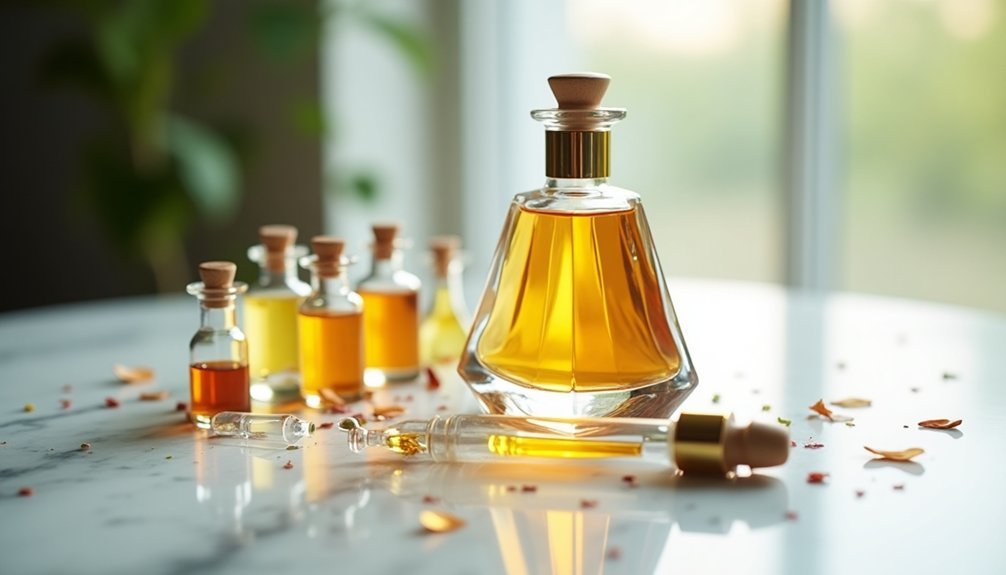Start with three basic perfume dilution ratios to create your own signature scent. For a light cologne, mix 5% fragrance oils with 95% alcohol. For a balanced eau de toilette, use 10% oils and 90% alcohol. For a stronger eau de parfum, blend 15% oils with 85% alcohol. Always measure carefully and perform a patch test before applying. These foundational ratios will help you reveal the art of perfume making.
Basic Carrier Oil Dilution Ratios For Essential Oil Perfumes

When creating essential oil perfumes, understanding proper dilution ratios is crucial for both safety and effectiveness.
You'll want to start with a 1% dilution if you're new to essential oils or have sensitive skin, which means adding just one drop of essential oil per teaspoon of carrier oil. For most adult applications, a 2% dilution works well, requiring two drops per teaspoon.
If you're targeting specific areas or acute conditions, you can increase to a 3% dilution with three drops per teaspoon. However, never exceed a 5% dilution for topical use, as this can irritate your skin.
Remember to measure carefully and always perform a patch test before applying your blend. Using high-quality carrier oils like jojoba or grapeseed will help maintain your perfume's effectiveness while providing additional skin benefits. Storing your perfume blends in dark glass bottles will help extend their shelf life by preventing degradation from light exposure.
Creating Alcohol-Based Perfumes With Perfect Drop Measurements
Although creating alcohol-based perfumes may seem intimidating, mastering precise drop measurements will guarantee your fragrances turn out perfectly every time.
You'll need to focus on weight-based measurements using a calibrated electronic scale for the most accurate results.
When working with alcohol-based perfumes, you'll follow standard concentration ratios: 20% oils for perfume, 15% for EDP, 10% for EDT, and 5% for cologne.
For example, if you're making a 100ml EDT, you'll use 10ml of fragrance oils and 90ml of alcohol. Fill your bottle with perfumer's alcohol to approximately two-thirds full before adding other ingredients.
Always use proper tools like pipettes for liquids and spatulas for solids.
When scaling up your formulas, convert drops to grams to maintain consistency.
Remember to zero your scale before each measurement and keep all your units consistent throughout the process.
Safe Dilution Guidelines For Natural Fragrance Blending

Beyond mastering alcohol-based perfumes, understanding safe dilution practices forms the backbone of natural fragrance blending.
You'll need to follow specific concentration ranges based on your desired fragrance type, from the lightest Eau Fraiche at 1-3% to the most concentrated Extrait at 15-30%.
When working with essential oils, remember they're highly concentrated – it takes 200 kg of lavender flowers to produce just 1 kg of oil.
You'll get better results using lower concentrations, as essential oils are more active in diluted forms. Working with diluted materials allows for more accurate measurements and cost-effective experimentation compared to using raw ingredients.
While a few oils like lavender and tea tree can be used neat, most require proper dilution to prevent skin irritation.
Always perform a patch test before creating your blend, and start with the lowest recommended concentration for your chosen fragrance format.
Frequently Asked Questions
How Long Should I Let My Perfume Mature Before Using It?
You'll want to let your perfume mature for at least 2-7 days if it's simple, or up to 3 months for complex blends. You'll get better results the longer you wait, especially in cool, dark storage.
Can I Mix Different Carrier Oils Together in One Perfume Blend?
Yes, you can mix carrier oils together in your perfume blend. It's a great way to customize viscosity and combine different skin benefits. Just make certain they're compatible and test the mixture first.
Why Does My Perfume Scent Fade so Quickly After Application?
Your perfume's quick fading could be due to dry skin, high temperatures, or low concentration. Try moisturizing before application, applying to pulse points, and choosing higher concentration formulas like Eau de Parfum.
What's the Shelf Life of Homemade Perfumes Using Natural Ingredients?
Your homemade natural perfumes typically last 6-12 months. They'll stay fresh longer if you're storing them in dark bottles, keeping them cool, and adding natural preservatives like vitamin E or rosemary extract.
Should I Store My Perfume Blends in Dark or Clear Glass Bottles?
You'll want to use dark glass bottles for your perfume blends. They protect against UV rays that can degrade your fragrances. If you're using clear bottles, make sure to store them in dark places.
In Summary
You'll find perfume making becomes easier once you've mastered these basic dilution ratios. Whether you're working with carrier oils or alcohol bases, start with conservative measurements and adjust to your preferences. Remember to always follow safe dilution guidelines of 1-3% for body applications. Keep experimenting with different combinations while staying within these recommended ratios, and you'll create unique, perfectly balanced fragrances.





Leave a Reply